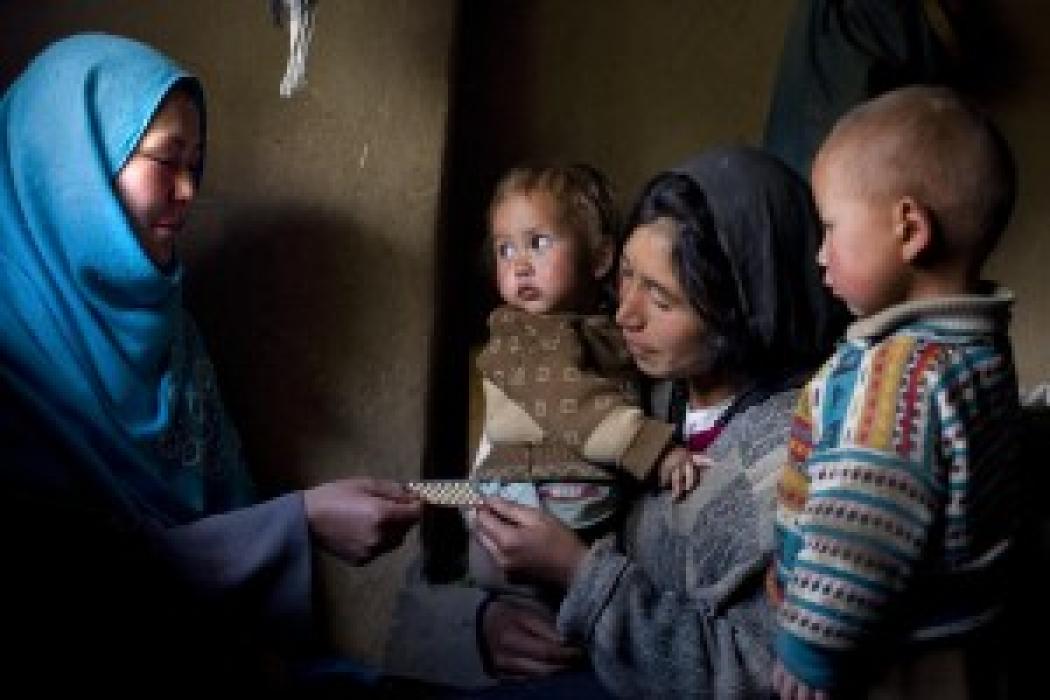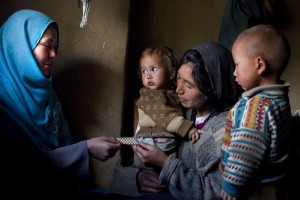How to save 3.6 million children each year? Invest in community health workers

By Julia Bluestone, Jhpiego
The following is a Q&A between Julia Bluestone of Jhpiego and the Frontline Health Workers Coalition and Dr. Henry Perry of the Johns Hopkins Bloomberg School of Public Health on a recently released report examining community health workers’ effectiveness in saving lives and improving health. The post was originally published in the Bill & Melinda Gates Foundation’s Impatient Optimists blog.
 Community health worker (CHW) Ozara Husseini (left) talks to Najiba, who has five children, about the advantages of family planning and Najiba's decisions to start taking the pill at their home in Katasank near Bamyan, Afghanistan, on the June 8, 2010. Photo by Kate Holt, Jhpiego
Community health worker (CHW) Ozara Husseini (left) talks to Najiba, who has five children, about the advantages of family planning and Najiba's decisions to start taking the pill at their home in Katasank near Bamyan, Afghanistan, on the June 8, 2010. Photo by Kate Holt, Jhpiego
Utilizing community health workers (CHW) to deliver health services to women and families can significantly improve the health of children and potentially save 3.6 million children’s lives each year. That’s the conclusion of a report by Dr. Henry Perry and Rose Zulliger of the Johns Hopkins Bloomberg School of Public Health, commissioned by the MDG Health Alliance.
As a member of the Frontline Health Workers Coalition, Jhpiego was interested in these findings to support the importance of community health workers on the frontlines. I interviewed Dr. Perry on the key takeaways from this report and the potential impact of CHWs on achieving the Millennium Development Goals (MDGs):
What surprised you the most about what you found in this report?
That no one has ever pulled together all the evidence related to the effectiveness of CHW programs for reaching the health-related MDGs. Also, there has been almost no attention on the centrality of CHWs for making measurable gains in the health-related MDGs.
There is a call just recently endorsed by the African Union for 1 million CHWs in Africa that uses this argument as its central theme.
Until recently, the focus has always been on the intervention itself and not on how it is delivered. We found that, based on current evidence, if CHWs are used to deliver the interventions they are capable of delivering and if 100% coverage could be attained, then the lives of 3.6 million children would be saved every year. Isn’t that a significant motivation for greater investment in CHW programming?
Which CHW-delivered interventions have the most promise to reduce maternal and child mortality?
(1) Family planning services
(2) Community-based distribution of misoprostol (for reducing the risk of post-partum hemorrhage of women who deliver at home)
(3) Home-based immediate and essential neonatal care
(4) Promotion of exclusive breastfeeding during the first six months of life
(5) Integrated community case management of childhood illness (pneumonia, diarrhea and, where appropriate, malaria)
(6) Promotion and provision of immunizations
In your review, was there a country that utilized and supported CHW’s effectively? If so, what lessons can we apply to other countries based on that experience?
Brazil has the second largest CHW program in the world with 223,000 community health agents (CHAs). CHAs are integrated into health teams, and they visit every family once per month for health promotion and link families to the health system when necessary.
This national program reaches 110 million people. Health teams comprised of one doctor, one nurse, one assistant nurse and six CHAs provide comprehensive care for 1,000 families in a defined geographic area. The CHWs are salaried and work full time.
The program has been associated with significant improvements in health outcomes. Brazil has one of the most rapidly declining mortality rates for children under age 5 in the world—it achieved its Millennium Development Goal for child mortality in 2010, five years ahead of the targeted date. Only 2% of children are underweight and immunization coverage is 99%. Other countries, including South Africa, are now establishing CHW programs based on the Brazil model.
If you could leave us with one key takeaway, what would it be?
The evidence overwhelmingly supports the effectiveness of CHWs to achieve the Millennium Development Goals.
We have taken each of the MDGs and found evidence indicating CHWs were used to provide interventions that led to measurable progress in health-related MDG indicators. Unfortunately, much of the evidence arises from smaller-scale projects conducted in relatively ideal settings for only a few years. Nonetheless, there are powerful national examples of CHWs providing a central role in achieving the health-related MDGs—including Brazil, Bangladesh and Nepal—that can guide other countries to achieve similar progress.
Given the strength of the evidence, we need to push for strong CHW programs in countries with high disease burdens. This means not only selecting and training these workers, but ensuring that proper health systems are in place to keep them functioning well. Unfortunately, this did not occur in the 1980s and many CHW programs failed. CHWs need appropriate incentives, strong supervision and adequate logistical support for the drugs and supplies needed in their work. If these are not present, CHWs can’t be effective, they get demoralized, and communities lose interest in listening to them and making use of their services.
The full report “Review of CHW Effectiveness for MDGs” is available at: http://www.coregroup.org/our-technical-work/program-learning/community-health-workers/327-review-of-chw-effectiveness-for-mdgs
Dr. Henry Perry is a physician and Senior Associate in the Health Systems Program of the Department of International Health at the Johns Hopkins Bloomberg School of Public Health. He has spent more than three decades working in community health and primary health care.
Julia Bluestone is member of the Frontline Health Workers Coalition steering committee, a nurse-midwife and senior technical advisor for the global learning office at Jhpiego, which has supported the training of more than 16,000 CHWs to help increase access to essential health care.
